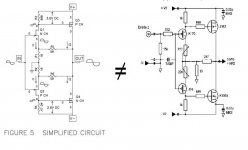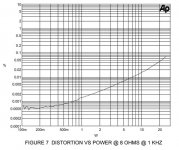The first time I saw the circuit (Profet I meant), I was quite impressed by its simplicity. The only concern then was the relatively low gain, espscially with lateral FETs. I guess using high transconductance FETs would solve part of the problem.
There are not that many true complimentary FETs around, which is why I have so far shy from building anything complementary other than a pre with all K170's / J74's.
Maybe I shall try this some time.
Patrick
There are not that many true complimentary FETs around, which is why I have so far shy from building anything complementary other than a pre with all K170's / J74's.
Maybe I shall try this some time.
Patrick
It reminds me to the ZEN V5....tarted up with an input buffer..
Nelson is still able to eliminate parts from something I thought was already minimalistic... http://www.diyaudio.com/forums/showthread.php?postid=613792#post613792
Current feedback is fast, eh??
Cheers, Tino
Nelson is still able to eliminate parts from something I thought was already minimalistic... http://www.diyaudio.com/forums/showthread.php?postid=613792#post613792
In case you haven't already seen the square wave....
Current feedback is fast, eh??
Cheers, Tino
zinsula said:It reminds me to the ZEN V5....tarted up with an input buffer..
http://www.diyaudio.com/forums/showthread.php?postid=613792#post613792
Current feedback is fast, eh?
The output stage looks like the ZV5 (MOSFET complementary
Common Source) but the input system is Common Source also.
And yes, "current feedback" is pretty fast.
Early on I put together a power amp with the topology of your
reference, but I found that if you're going to go to the trouble
of dual-diff pairs, you may as well go all the way, as with the
post that followed it. Logically, joining two of these at the hip,
that is to say the Source junctions of the JFETs, and using power
MOSFETs you create a power UGS.
Now I've done it. The F5 isn't even out and some of you will
already be scrambling to build the two balanced versions.

Zen Mod said:
talking about Profet ;
NFB is bloody different
Returning the feedback to the cathode is quite common in the tube world, but for some reason it never quite caught on with the solid state folks. As a result, I expect we'll see a couple of variations on the idea show up in the Pass Labs forum over the next month or two. Just remember one thing when you're trying this: You're running the feedback into a low impedance node. It makes a difference.
Grey
zinsula said:......
Current feedback is fast, eh??
Cheers, Tino

Papa - cascodes are referenced to gnd , or to some other funny place(s)
 ?
?Attachments
Zen Mod said:talking about Profet ;
NFB is bloody different
Much of the difference is due to the high degeneration of their
input JFETs, the lower transconductance of Laterals and their relatively
high output gain. This means a lot less feedback, as seen by the
output impedance and distortion specs.
For Common Source topologies, damping factor = feedback.
EUVL said:I guess you won't be showing us any measurements of distortion or bandwidth until the article is out ?
You can look at posts #1740 and 1741 in DIY Progress Report, and
here earlier I posted a 2 ohm distortion curve. Here's an 8 ohm
curve, this with a regulated supply.
Attachments
> And yes, "current feedback" is pretty fast.
I must be still asleep.
I am not sure which part of the circuit you are referring to is current feedback.
For global current feedback, e.g., I would expect the feedback signal be derived from a sensing resistor in series with the load. Since the output current does not go through the 2x 50R feedback resistors, at least the global loop is voltage feedback, be it with a twist.
Anyone care to explain to me, Tino ?
Patrick
I must be still asleep.
I am not sure which part of the circuit you are referring to is current feedback.
For global current feedback, e.g., I would expect the feedback signal be derived from a sensing resistor in series with the load. Since the output current does not go through the 2x 50R feedback resistors, at least the global loop is voltage feedback, be it with a twist.
Anyone care to explain to me, Tino ?
Patrick
Nelson Pass said:
You can look at posts #1740 and 1741 in DIY Progress Report, and
here earlier I posted a 2 ohm distortion curve. Here's an 8 ohm
curve, this with a regulated supply.
Does the F5 have a regulator for each rail ?
Nelson Pass said:
...............
Now I've done it. The F5 isn't even out and some of you will
already be scrambling to build the two balanced versions.

...are you kidding me? The group buy started this morning

EUVL said:> And yes, "current feedback" is pretty fast.
I am not sure which part of the circuit you are referring to is current feedback.
For global current feedback, e.g., I would expect the feedback signal be derived from a sensing resistor in series with the load. Since the output current does not go through the 2x 50R feedback resistors, at least the global loop is voltage feedback, be it with a twist.
You are quite right, and that's why "current feedback" is in quotes.
As I have previously pointed out elsewhere and in the F5 write-up,
this term probably came from the marketing departments at the
chip companies when they began selling high speed op amps using
this approach.
- Home
- Amplifiers
- Pass Labs
- F5 power amplifier

